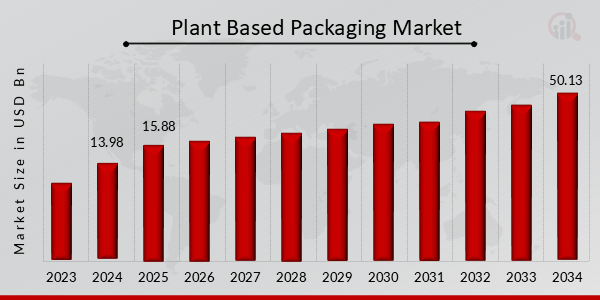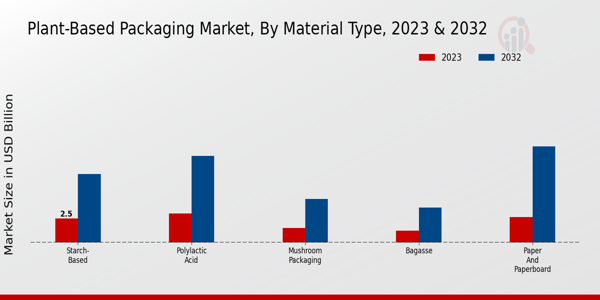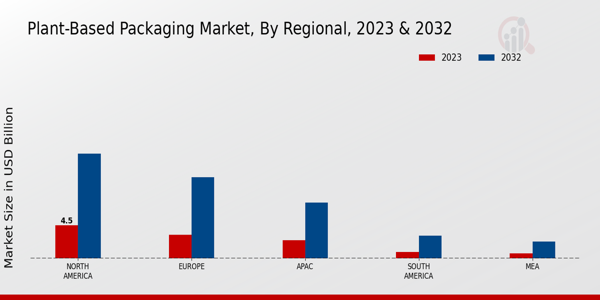Global Plant Based Packaging Market Overview
The Plant Based Packaging Market Size was estimated at 13.98 (USD Billion) in 2024. Plant Based Packaging Industry is expected to grow from 15.88 (USD Billion) in 2025 to 50.13 (USD Billion) by 2034, at a CAGR (growth rate) is expected to be around 13.60% during the forecast period (2025 - 2034)
Key Plant-Based Packaging Market Trends Highlighted
The Global Plant-Based Packaging Market is driven by a growing awareness of environmental issues and the need for sustainable alternatives to traditional packaging materials. Consumers and businesses are becoming increasingly concerned about plastic waste and its impact on the planet. This shift in mindset is pushing companies to seek out eco-friendly options that reduce their carbon footprint and align with their sustainability goals. The demand for plant-based packaging is further fueled by changes in regulations aimed at reducing single-use plastics and encouraging the use of renewable resources. These drivers create a strong momentum for growth in the market.Opportunities abound for innovation in plant-based packaging materials. As technology advances, new biodegradable and compostable materials are being developed, offering superior performance compared to conventional options. The rise of e-commerce and the increasing focus on sustainable packaging solutions across various industries, such as food and beverages, further present opportunities for businesses to expand their portfolios. The collaboration between companies to develop plant-based packaging solutions also opens doors for unique partnerships and market differentiation. Brands that adopt these solutions stand to gain a competitive advantage in a marketplace that increasingly favors sustainability.Recently, the market has seen notable trends, such as the adoption of smarter packaging solutions that incorporate features like freshness indicators and recyclable designs. In addition, consumer preferences are shifting towards brands that demonstrate accountability and transparency in their sourcing and packaging materials. This trend emphasizes the importance of storytelling around sustainability, as consumers want to understand how their choices impact the environment. Furthermore, the integration of circular economy principles is gaining traction as businesses focus on creating packaging systems that allow materials to be reused or recycled, thus reducing waste and increasing resource efficiency.

Source: Primary Research, Secondary Research, MRFR Database and Analyst Review
Plant-Based Packaging Market Drivers
Growing Environmental Concerns
As consumers become increasingly aware of the detrimental effects of plastic pollution on the environment, the demand for sustainable alternatives has surged. The Global Plant-Based Packaging Market Industry is witnessing a shift towards eco-friendly packaging solutions that minimize waste and reduce carbon footprints. Plant-based packaging materials, derived from renewable resources like corn, sugarcane, and other biomaterials, offer a viable substitute for traditional petroleum-based plastics.This growing environmental consciousness among both consumers and businesses has driven innovation in the packaging sector, with manufacturers investing in research and development to create biodegradable and compostable packaging options. Regulatory bodies around the globe are also playing a crucial role in pushing for stricter guidelines on plastic usage, further fueling the growth of the plant-based packaging market. The need for compliance with these regulations, along with the pressure from stakeholders to adopt more sustainable practices, is encouraging companies to transition to plant-based materials.As a result, the Global Plant-Based Packaging Market Industry is expected to expand significantly, catering to the rising preference for sustainable products across various industries, including food and beverage, cosmetics, and e-commerce. The emphasis on circular economy principles is also motivating businesses to rethink their packaging strategies and invest in plant-based solutions, thereby propelling market growth in the coming years. With increasing investments in sustainable packaging technologies, the market landscape is evolving rapidly, presenting opportunities for new players and innovative solutions that address environmental concerns.
Shifting Consumer Preferences
Modern consumers are exhibiting a noticeable preference for sustainable and environmentally friendly products, which extends to their packaging choices. The Global Plant-Based Packaging Market Industry is benefitting significantly from this shift. As informed consumers actively seek products that align with their values, companies are motivated to adopt plant-based packaging solutions that reflect these preferences. This demand for eco-conscious packaging is often viewed as a brand differentiator, enhancing corporate reputation and customer loyalty.
Technological Advancements in Packaging Solutions
Technological innovations in the development of plant-based materials are enhancing the efficiency and quality of packaging solutions. The Global Plant-Based Packaging Market Industry is experiencing improvements in production processes and material formulations, leading to better performance characteristics that meet consumer and industry standards. These advancements not only drive market growth but also foster competitiveness as new entrants emerge with innovative offerings.
Plant-Based Packaging Market Segment Insights:
Plant-Based Packaging Market Material Type Insights
The Global Plant-Based Packaging Market has shown significant growth, with a total valuation of 10.83 USD Billion in 2023. An essential aspect of this market is its segmentation by Material Type, which encompasses various innovative and sustainable alternatives to traditional packaging. The categories within this segment include Starch-Based, Polylactic Acid, Mushroom Packaging, Bagasse, and Paper and Paperboard, each contributing to the market's expansion uniquely.
In this classification, Starch-Based packaging emerges as one of the prominent players, valued at 2.5 USD Billion in 2023 and expected to reach 7.1 USD Billion by 2032. Its expanding market presence can be attributed to its abundance, cost-effectiveness, and biodegradability, making it an attractive option for businesses looking to reduce their environmental footprint. Polylactic Acid follows closely, reflecting a valuation of 3.0 USD Billion in 2023, with projections of 9.0 USD Billion by 2032. This material is significant not only due to its compostable nature but also its versatile applications, appealing to various industries, thus driving the Global Plant-Based Packaging Market revenue further.
Mushroom Packaging, though smaller at a valuation of 1.5 USD Billion in 2023, is gaining interest for its remarkable sustainability and ability to be molded into various shapes, making it a unique contender in this market. Bagasse, valued at 1.2 USD Billion in 2023, serves as an efficient solution derived from sugarcane residue, further emphasizing the use of agricultural by-products in sustainable packaging. This segment signifies potential growth avenues due to the rising demand for eco-friendly alternatives in food packaging and tableware.
Lastly, Paper and Paperboard, which accounts for a valuation of 2.63 USD Billion in 2023 and is forecasted to rise to 10.0 USD Billion by 2032, dominates the market due to its recyclability, consumer familiarity, and adaptability across multiple sectors, particularly in retail and e-commerce. The increasing consumer preference for sustainable materials and government regulations targeting plastic reduction further bolster the market growth for these material types. In summary, the various material types within the Global Plant-Based Packaging Market showcase diversity and innovation in eco-friendly alternatives, pushing the industry towards a sustainable future with considerable market potential across the board.

Source: Primary Research, Secondary Research, MRFR Database and Analyst Review
Plant-Based Packaging Market Application Insights
The Global Plant-Based Packaging Market is experiencing notable growth, being valued at 10.83 USD Billion in 2023, with a significant upward trajectory expected in the coming years. The Application segment showcases a diverse array of uses, including Food Packaging, Beverage Packaging, Consumer Goods Packaging, and Pharmaceutical Packaging. Food Packaging is particularly crucial, given the rising trend toward eco-friendly solutions in response to consumer demands for sustainable alternatives. Beverage Packaging also plays a vital role, driven by the increasing preference for plant-based materials in packaging solutions that promote recycling and reduce environmental impact.Consumer Goods Packaging holds a significant share as brands increasingly adopt sustainable practices to meet regulatory standards and customer preferences. The Pharmaceutical Packaging sector is gaining momentum as the focus on safety and sustainability becomes more pronounced, making plant-based materials a desirable option. Collectively, these applications reflect the broader Global Plant-Based Packaging Market statistics, which illustrate a robust shift toward sustainable packaging solutions, propelled by growing awareness of environmental issues and the push for reduced plastic consumption.
Plant-Based Packaging Market End-Use Insights
The Global Plant-Based Packaging Market is experiencing significant growth, driven by increasing consumer awareness and demand for sustainable solutions across various end-use sectors. In 2023, the market was valued at 10.83 USD Billion, with its expansion expected to continue robustly, reaching a valuation of 34.2 USD Billion by 2032. Key segments within this market include the Food and Beverage Industry, which holds a majority share due to heightened emphasis on eco-friendly packaging alternatives to reduce environmental impact. Additionally, the Personal Care and Cosmetics sector is significant as brands shift towards plant-based materials in response to consumer preferences for sustainable products.The Healthcare industry also plays a crucial role, leveraging plant-based packaging to ensure safety and sustainability in medical applications. Lastly, the Electronics sector is increasingly adopting plant-based packaging solutions, not only to meet regulatory requirements but also to appeal to environmentally conscious consumers. The recognition of sustainability as a priority across these industries reflects larger market growth dynamics, highlighting an opportunity for innovations that align with ecologically responsible practices. This evolution in the Global Plant-Based Packaging Market underscores its pivotal role in fostering a greener future while addressing consumer needs and regulatory standards.
Plant-Based Packaging Market Packaging Type Insights
The Global Plant-Based Packaging Market is experiencing meaningful growth, with a significant focus on the Packaging Type segment. In 2023, the overall market was valued at 10.83 USD Billion, reflecting a robust interest in sustainable alternatives to traditional packaging. This segment encompasses various forms of packaging, including Rigid Packaging, Flexible Packaging, and Semi-Rigid Packaging. Rigid Packaging plays a crucial role due to its strength and protective qualities, often dominating the market owing to its widespread application across multiple industries.Flexible Packaging is also seeing growth, appealing to consumers' demands for convenience and versatility, while Semi-Rigid Packaging caters to the need for lightweight yet sturdy options, providing a balance between both rigidity and flexibility. The segmentation of the Global Plant-Based Packaging Market enables players to strategically navigate market trends, with increasing consumer preference for eco-friendly options driving demand.
Plant-Based Packaging Market Regional Insights
The Global Plant-Based Packaging Market is experiencing substantial growth across various regions, with the overall market valued at 10.83 USD Billion in 2023 and projected to reach 34.2 USD Billion by 2032. North America is the dominant player in this market, holding a valuation of 4.5 USD Billion in 2023 and expected to grow significantly to 14.2 USD Billion by 2032, showcasing its majority holding due to increasing investments in sustainable packaging solutions. Europe follows as a significant market, valued at 3.2 USD Billion in 2023, with a forecast to reach 11.0 USD Billion by 2032, driven by stringent regulations promoting eco-friendly products.The Asia-Pacific (APAC) region also plays a crucial role, valued at 2.5 USD Billion in 2023, expanding to 7.6 USD Billion by 2032, indicating a growing acceptance of plant-based materials amid rapid industrialization. South America and the MEA regions, while currently smaller players with valuations of 0.9 USD Billion and 0.73 USD Billion, respectively, in 2023, show promise for growth, projected to reach 3.1 USD Billion and 2.3 USD Billion by 2032 as demand for sustainable packaging solutions rises. Overall, the Global Plant-Based Packaging Market segmentation reveals significant opportunities for growth driven by changing consumer preferences and regulatory frameworks favoring sustainable practices.

Source: Primary Research, Secondary Research, MRFR Database and Analyst Review
Plant-Based Packaging Market Key Players and Competitive Insights:
The Global Plant-Based Packaging Market is witnessing dynamic growth as consumer preferences shift towards sustainable and eco-friendly packaging solutions. This competitive landscape involves a range of players who are innovating and adapting to meet the demands of environmentally conscious consumers and regulatory pressures. The market has become a battleground for companies striving to create biodegradable, compostable, and recyclable products from renewable resources.
As sustainability becomes a primary concern within the packaging industry, firms are focusing their strategies on developing plant-based materials that reduce reliance on traditional plastics, often derived from fossil fuels. Competitive insights reveal that collaboration, research and development, and efficient supply chain management are crucial for gaining a competitive edge, allowing companies to capture market share while addressing various sustainability goals effectively.Mondi Group stands out in the Global Plant-Based Packaging Market due to its commitment to sustainability and innovation. The company has leveraged its expertise in packaging solutions to develop a range of plant-based products that cater to various sectors, including food, personal care, and industrial applications. Mondi Group's strong market presence is attributed to its ability to effectively combine its extensive research capabilities with its well-established production facilities. This has enabled the company to create high-performance packaging solutions that not only meet the needs of customers but also align with global sustainability trends.
BioPak is significantly influential in the Global Plant-Based Packaging Market, recognized for its commitment to sustainability and innovative product lines. With an emphasis on compostable solutions, BioPak is primarily focused on providing eco-friendly packaging options that resonate with environmentally aware consumers and businesses. The company has built a robust reputation for delivering high-quality products that are not only functional but also contribute to reducing waste in the environment.
Key Companies in the Plant-Based Packaging Market Include:
Plant-Based Packaging Market Industry Developments
Recent developments in the Global Plant-Based Packaging Market demonstrate significant advancements and rising interest in sustainable packaging solutions. Companies like Mondi Group and Amcor are increasingly investing in innovative plant-based materials that not only reduce environmental impact but also meet consumer demand for sustainable products. DS Smith and Crown Holdings have announced expansions in their production capabilities, focusing on eco-friendly packaging alternatives. In terms of mergers and acquisitions, BioPak has been recognized for acquiring smaller market players enhancing its portfolio in sustainable packaging solutions, while Smurfit Kappa continues to grow through the acquisition of local environmentally friendly brands. Elevate Packaging and NatureFlex are collaborating with various brands to improve the durability and functionality of plant-based packaging, while Tetra Pak is working to enhance the recyclability of its solutions. The market valuation is on an upward trend, with increased investor interest fueled by a global shift towards sustainability and eco-conscious consumer behaviors, emphasizing the importance of plant-based options in meeting both regulatory requirements and customer expectations. Overall, these developments signify a robust evolution within the sector, driving both innovation and growth in the Global Plant-Based Packaging Market.
Plant-Based Packaging Market Segmentation Insights
-
Plant-Based Packaging Market Material Type Outlook
-
Plant-Based Packaging Market Application Outlook
-
Plant-Based Packaging Market End-Use Outlook
- Food and Beverage Industry
- Personal Care and Cosmetics
-
Plant-Based Packaging Market Packaging Type Outlook
-
Plant-Based Packaging Market Regional Outlook
|
Report Attribute/Metric
|
Details
|
|
Market Size 2024
|
13.98 (USD Billion)
|
|
Market Size 2025
|
15.88 (USD Billion)
|
|
Market Size 2034
|
50.13 (USD Billion)
|
|
Compound Annual Growth Rate (CAGR)
|
13.60% (2025 - 2034)
|
|
Report Coverage
|
Revenue Forecast, Competitive Landscape, Growth Factors, and Trends
|
|
Base Year
|
2024
|
|
Market Forecast Period
|
2025 - 2034
|
|
Historical Data
|
2020 - 2024
|
| Market Forecast Units |
USD Billion |
| Key Companies Profiled |
Mondi Group, BioPak, Crown Holdings, Amcor, Sappi, DS Smith, Elevate Packaging, Earthpack, NatureFlex, Ball Corporation, Smurfit Kappa, Tetra Pak, Plantic Technologies, Biopak, Sealed Air |
| Segments Covered |
Material Type, Application, End Use, Packaging Type, Regional |
| Key Market Opportunities |
Sustainable consumer preferences, Regulatory support for eco-friendly products, Innovations in biodegradable materials, Expansion of e-commerce packaging solutions, Growing demand in the food service industry |
| Key Market Dynamics |
Sustainability awareness increase, Regulatory support and incentives, Rising demand for eco-friendly solutions, Technological advancements in packaging, Competitive pressure from alternatives |
| Countries Covered |
North America, Europe, APAC, South America, MEA |
Frequently Asked Questions (FAQ) :
The Global Plant-Based Packaging Market is expected to be valued at 50.13 USD Billion in 2034.
The forecasted CAGR for the Global Plant-Based Packaging Market is 13.60% from 2025 to 2034.
North America is anticipated to have the largest market size for Plant-Based Packaging, expected to reach 14.2 USD Billion in 2032.
The projected market size for Starch-Based materials is expected to be 7.1 USD Billion in 2032.
Key players in the Global Plant-Based Packaging Market include Mondi Group, BioPak, Crown Holdings, Amcor, and Sappi.
Polylactic Acid is expected to have a market value of 9.0 USD Billion in Plant-Based Packaging by 2032.
The Paper and Paperboard segment is expected to grow to 10.0 USD Billion by 2032.
The Global Plant-Based Packaging Market may face challenges such as supply chain disruptions and the need for innovation in materials.
The Asia-Pacific region is expected to reach a market size of 7.6 USD Billion for Plant-Based Packaging in 2032.
The growth of the Global Plant-Based Packaging Market is significantly influenced by increasing consumer demand for sustainable and eco-friendly packaging solutions.
















